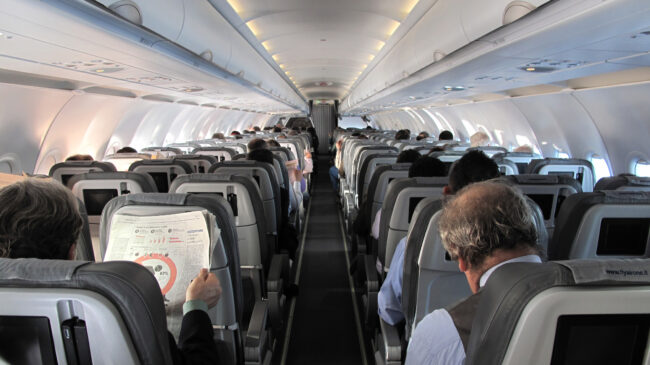The COVID-19 pandemic threw the world into chaos, disrupting everyday life and dramatically impacting economic activity in countless ways. One of the hardest-hit sectors was transportation in general and commercial aviation in particular, which saw travel decline by 95% at its nadir in the spring of 2020.
Aviation’s recovery since then continues to offer surprises, with surging leisure travel straining capacity still limited by insufficient employees and assets as the industry attempts to serve new travel demand patterns. This has contributed to widely publicized service breakdowns at airlines, airports, security screening, and air traffic control.
In response to this turmoil, some misguided activists and politicians have suggested reversing successful reforms from the 1970s and ‘80s that liberalized rules governing airline competition. This would be a terrible mistake.
Calls for undoing airline deregulation misapprehend the actual problems and would reverse the massive gains enjoyed by consumers since the Airline Deregulation Act of 1978. As I argue in a new Reason Foundation policy brief, responsible and well-informed policymakers seeking to enhance consumer welfare should instead build on the clear success of airline deregulation by examining further pro-competitive reforms to policies governing aviation consumer protection, airport access, and airline cabotage.
Civil aviation in the United States took off in the years following World War I and was primarily focused on long-distance airmail delivery for the U.S. Post Office. While aircraft manufacturing in the 1920s was characterized by intense entrepreneurial competition and experimentation, most air service was dictated by government airmail contracts.
Following a scandal in the early 1930s surrounding a conspiracy between the Post Office and the nascent airline industry to rig contract bids and cartelize the industry, President Franklin Roosevelt nationalized airmail delivery by replacing corrupt contracting with the Army Air Corps. A dozen inexperienced Army pilots were soon killed in crashes, creating another scandal and leading to the re-introduction of competitive airmail contracts. It was during this tumultuous period that Congress and the White House began investigating a comprehensive civil aviation regulatory framework that would support growing commercial passenger and cargo operations.
Born in a scandal over government and business collusion to establish an anticompetitive cartel, the Civil Aeronautics Act of 1938 created the aviation economic and safety regulatory framework that would persist until the late 1970s. Most ironically, a key feature of this law was the establishment of a new cartel of scheduled interstate “trunk carriers” composed of the 23 existing airlines. Under the goal of “managed competition,” routes and prices were set by regulators at the Civil Aeronautics Board (CAB), which also prevented new airlines from competing with established trunk carriers.
However, the Civil Aeronautics Board’s jurisdiction only applied to flights between states. Airlines operating exclusively within states were able to operate free of the CAB’s entry, route, and price regulations.
In 1949, Kenny Friedkin founded Pacific Southwest Airlines (PSA) in California. A decade later, PSA began serving the high-volume Los Angeles-San Francisco market. Because it was not subject to the CAB’s federal airline cartel, PSA was able to offer much lower airfares—less than half of those charged by Civil Aeronautics Board-regulated trunk carriers over comparable distances. PSA’s success in California inspired Herb Kelleher to cofound Southwest Airlines in 1965 as a Texas intrastate carrier, which adopted many of PSA’s low-cost business practices.
One person watching this play out was future U.S. Supreme Court Justice Stephen Breyer, a native San Franciscan and then a professor at Harvard Law School. In the mid-1970s, Breyer was hired by Sen. Edward “Ted” Kennedy to investigate the Civil Aeronautics Board on behalf of his subcommittee.
As Breyer later wrote, “The investigation produced strong evidence that the Board itself maintained unnecessarily high fares, prevented—sometimes unlawfully—new low-fare airlines from entering the industry, and tried to stop service, as well as price, competition.”
Following the election of President Jimmy Carter in 1976, Cornell University economist Alfred Kahn, also a critic of the CAB’s cartel, was appointed to chair the Civil Aeronautics Board. Kahn, widely known as the “father of airline deregulation,” initiated a series of pro-competitive regulatory reforms upon becoming CAB chairman. Kahn then led the Carter administration’s role in developing comprehensive airline deregulation legislation.
Most carriers opposed deregulation at the time, but supporters of airline deregulation assembled a “strange bedfellows” coalition that brought together individuals, advocacy groups, and businesses as varied as Ralph Nader, the American Conservative Union, American Association of Retired Persons (AARP), National Association of Manufacturers, and Sears Roebuck.
These efforts in the legislative and executive branches culminated in the enactment of the Airline Deregulation Act of 1978, which eliminated most economic regulation of the airline industry and ultimately abolished the Civil Aeronautics Board. The key regulatory authorities that for four decades had allowed the CAB to fix prices, set routes, and prohibit entry by new competitors were phased out in favor of a “maximum reliance on competitive market forces.”
The initial years following airline deregulation saw many new interstate carrier entrants, most of which adopted a low-cost business model similar to what PSA and Southwest Airlines had done as intrastate carriers in California and Texas. Many of these new low-cost carriers offered high-frequency service at prices that were 40% to 70% below the airfares of the incumbent legacy trunk carriers. The legacy carriers then responded by lowering prices and adopting cost structures like those of the new entrants.
Aggressive price competition continues to broadly characterize the U.S. airline industry, where low-cost and now ultra-low-cost carriers put most of the downward pressure on airfares. In 2022, inflation-adjusted average airfares were 47% lower than they were in 1978. While lower fuel prices and improved technology explain some of this reduction, economists have attributed most of the decline in average prices since 1978 to improvements enabled by airline deregulation.
More recently, ultra-low-cost carriers such as Frontier Airlines and Spirit Airlines extended price competition by unbundling checked baggage and seat selection from base airfares and began charging a la carte fees for those ancillary services. These practices were soon mimicked by legacy network carriers. This has led to criticism that declines in airlines’ base fares misrepresent consumer gains because travelers must pay for services that were previously included with the purchase of tickets. However, examining “all-in” fare data (base fares plus baggage and ticket change fees) since 1990 shows a similar downward trend in prices.
The changes to the airline industry that followed deregulation have allowed many more people to travel. Between 1978 and 2019, the annual number of enplaned passengers more than tripled, growing five times faster than population growth. By 2017, 88% of Americans had flown in their lifetimes, and 48% had flown in the previous year, up from 63% and 25%, respectively, in 1977.
If Congress wishes to further enhance airline competition and consumer welfare, there are three areas worthy of attention. First, Congress should revise the definition of “unfairness” in the aviation consumer protection statute to mirror the one used by other federal consumer protection regulators, which would require a benefit-cost analysis to weigh a proposed regulation against “countervailing benefits to consumers or to competition.”
Second, Congress should examine two policies that limit airline access at airports: restrictions on airport self-financing and takeoff and landing slot controls. Eliminating the federal cap on local airport user fees, known as passenger facility charges (PFCs), would allow airports to build more gates to serve new entrants, which could enhance airline competition and save consumers billions of dollars a year on airfares. Replacing rigid slot controls at the most congested airports with a market mechanism, such as runway pricing, would also deter incumbent airlines from hoarding unpriced grandfathered slots to keep out lower-cost competitors, which would also put downward pressure on airfares.
Third, Congress should reexamine the longstanding prohibition on airline cabotage—the ability of foreign airlines to serve domestic routes. In the 1990s, the European Union liberalized cabotage rules among its member states. The result has been a dramatic increase in airline competition driven by ultra-low-cost carriers such as Ryanair and EasyJet, which in turn has led to comparable flights within Europe being much cheaper than those in the U.S., even when considering the higher taxes and fees imposed on European air travelers.
Policymakers are facing renewed pressure from misguided activists and others to resurrect the failed policies of the past—often in the name of promoting airline competition and consumer welfare. These proposals should be rejected. Instead, Congress should focus on addressing the remaining policy barriers to air carrier competition to usher in a new era of airline deregulation and the benefits to consumers that will result.
For more detail, read the full Reason Foundation policy brief, “Airline Deregulation: Past Experience and Future Reforms.”

